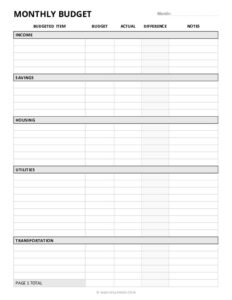Managing money doesn’t have to be stressful.
Whether you’re trying to save for a big goal, pay off debt, or make your paycheck last until the end of the month, a monthly budget planner can be your secret weapon.
In this guide, we’ll explore what a budget planner is, how to use one effectively, and tips to help you stay consistent.
What is a Monthly Budget Planner?

A monthly budget planner is a tool—digital or paper—that helps you track your income, expenses, savings, and financial goals on a month-by-month basis.
It provides a clear snapshot of your finances, allowing you to make informed decisions and avoid unnecessary spending.
Whether you use a printable template, an app, or a physical notebook, the purpose is the same: to help you plan and stay in control of your money.
Bonus: Recommended Amazon Products
If you’re ready to get started, check out these helpful tools:
-
✅ Clever Fox Budget Planner – Budget Organizer & Financial Planner Notebook
-
✅ Monthly Budget Planner Printable Sheets – Instant Download for Binder Use
-
✅ Cash Envelope System Wallet – Great for Category Spending
Why You Need a Monthly Budget Planner
-
Better Money Awareness
Many people don’t realize how much they’re spending until it’s too late. A budget planner helps you see exactly where your money is going. -
Prevents Overspending
With a monthly plan in place, you set limits on categories like groceries, entertainment, or shopping, helping you avoid impulse spending. -
Reduces Stress
Financial uncertainty causes anxiety. A budget planner provides structure and peace of mind, especially during tight months. -
Supports Financial Goals
Whether you’re saving for a vacation, emergency fund, or new home, a planner helps you track progress and stay motivated.
How to Set Up Your Monthly Budget Planner
Here’s a step-by-step breakdown of setting up your own budget:
1. List Your Income
Start with your total monthly income. Include:
-
Salary (after taxes)
-
Freelance or side hustle income
-
Passive income (dividends, rental, etc.)
📱 Join Our WhatsApp Food Channel!
Get daily ideas, decor tips, and exclusive room stylish deals — straight to your phone. Don’t miss out!
👉 Join Now
2. Track Fixed Expenses
These are regular monthly bills such as:
-
Rent or mortgage
-
Utilities
-
Car payments
-
Insurance
-
Subscriptions
3. Add Variable Expenses
These change from month to month and include:
-
Groceries
-
Gas
-
Dining out
-
Entertainment
-
Shopping
4. Include Savings & Debt Repayment
Set aside a portion for:
-
Emergency fund
-
Savings goals
-
Credit card or loan payments
5. Do the Math
Income – (Fixed + Variable + Savings + Debt) = What’s Left
If your result is negative, look for categories where you can cut back.
Tools You Can Use
-
Printable Planners – Great for hands-on people who like writing things down. [Example: Monthly Budget Printable on Etsy or Amazon]
-
Budgeting Apps – Try apps like Mint, YNAB (You Need A Budget), or Goodbudget.
-
Excel or Google Sheets – Perfect for customizing your own tracker with formulas.
-
Bullet Journals – For creative types who enjoy designing their own planner pages.
Monthly Budgeting Tips for Success
-
Review Weekly – Don’t wait until the end of the month to check your progress.
-
Be Realistic – Don’t set yourself up to fail. Allow room for fun and flexibility.
-
Use Cash Envelopes – For categories like dining or shopping to stay disciplined.
-
Plan for Unexpected Costs – Life happens! Include a buffer line in your budget.
-
Celebrate Small Wins – Even saving $50 extra a month is worth celebrating!
Final Thoughts
A monthly budget planner isn’t about restriction—it’s about freedom. When you know where your money is going, you feel more in control and confident in your financial future. Start today, and within just a few months, you’ll be amazed at how much progress you can make.
FAQs
Q: How long does it take to create a monthly budget?
A: Around 30–60 minutes the first time. It gets quicker each month!
Q: What if my income is irregular?
A: Base your budget on your lowest expected income, then adjust if you earn more.
Q: Should I involve my partner or family?
A: Yes! Budgeting together creates transparency and helps with shared goals.
Let your money work for you, not against you—start using a monthly budget planner today…
📱 Join Our WhatsApp Food Channel!
Get daily ideas, decor tips, and exclusive room stylish deals — straight to your phone. Don’t miss out!

